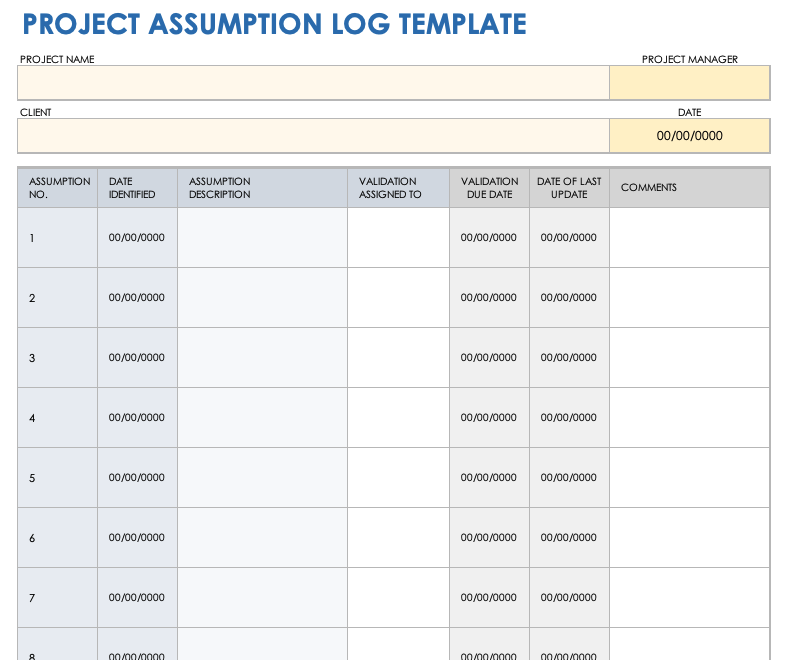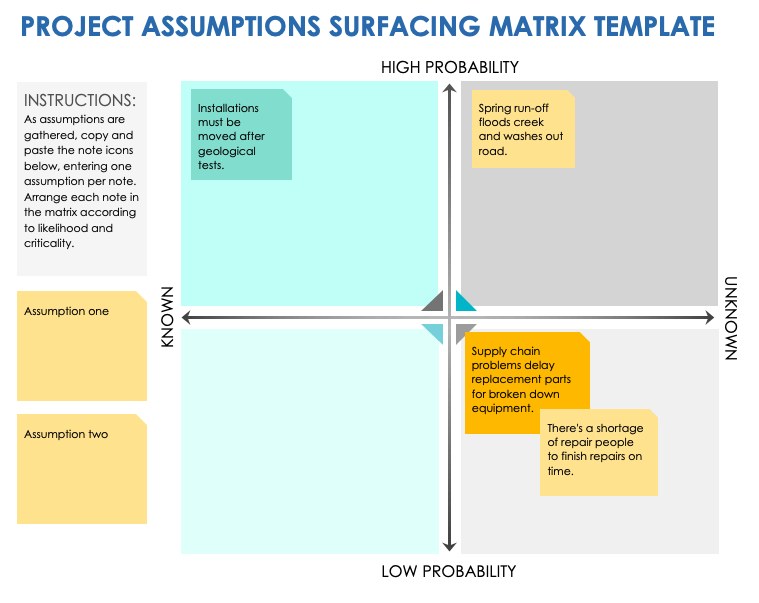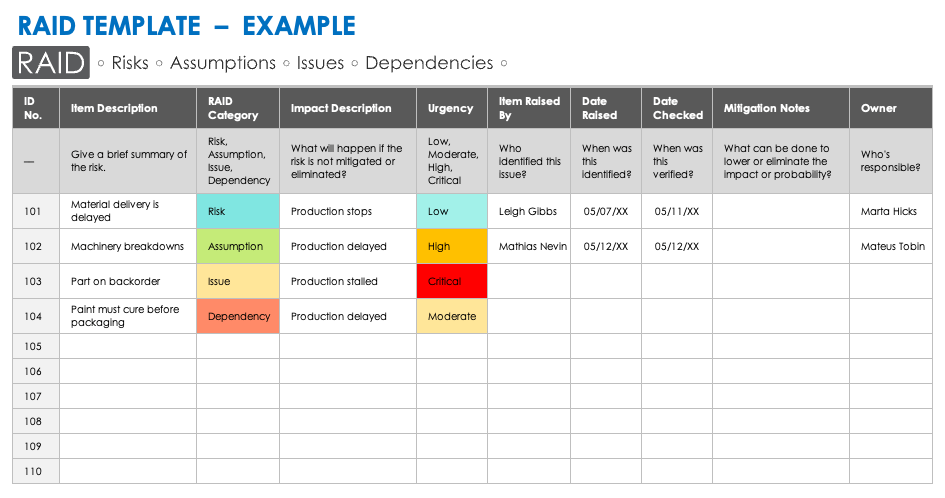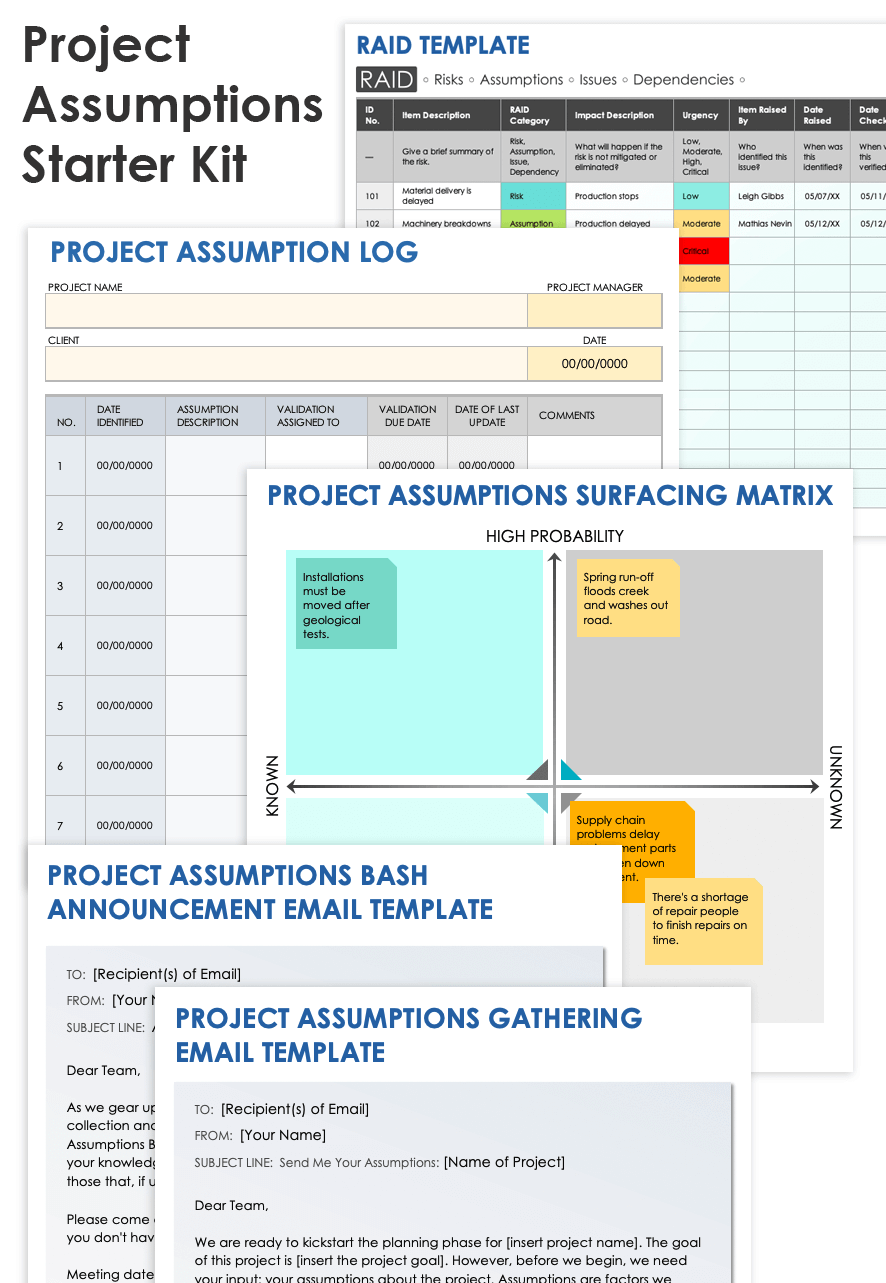What Are Assumptions in Project Management?
In project management, assumptions are factors that are believed to be true or certain, though their certainty cannot be fully confirmed. While assumptions come with risks, they serve as a foundation for progress in the face of uncertainty.
No one would ever start a project if they waited to eliminate all uncertainty, but a mistaken assumption can derail project strategy. "Therefore,” says Alan Zucker, founding principal of Project Management Essentials, “you need to document assumptions and validate or confirm them as soon as reasonable. Unvalidated assumptions get you in trouble because you make decisions on bad or partial information."
Everyone makes assumptions on a regular basis. Here are some assumptions we make in everyday life:
- The faucet will dispense water when turned on.
- The grocery store will have the items on your shopping list in stock.
- The internet connection at your office will be available and reliable.
- The alarm clock will wake you up at the time you set.
- There will be tea bags in the pantry for your morning tea.
If you rely on tea to get you going in the morning, you should regularly check your tea supply before you do your weekly shopping. Similarly, if you have an important meeting early in the morning, you might double-check your alarm or set an additional alarm before going to sleep.
In project management, key assumptions encompass such factors as assuming that there will be uninterrupted power supply at the office every workday or you’ll have an adequate supply of paper for the printer. Assumption analysis, a component of risk management in project planning, involves identifying these assumptions. Inaccurate assumptions can impact the triple constraint of time, money, and scope.
In their International Journal of Project Risk Management article, “Assumption Surfacing and Monitoring as a Tool in Project Risk Management,” Nils O. E. Olsson and Ingrid Spjelkavik use case studies to emphasize the importance of project assumptions as fundamental factors influencing the decision to initiate a project. They suggest identifying key assumptions upon which a project is based and presenting them in a format that allows comparison with the current situation.
Project managers derive project assumptions from educated guesses, past experience, and available information. While these factors are typically beyond a manager’s control, it is essential to closely monitor them in order to make quick, accurate adjustments as needed.
Ideally, project assumptions are gathered during the project initiation phase. The project manager lists assumptions in various project documents, such as the business case, project charter, contracts, proposals, scopes of work, and project plans. In contracts, the inclusion of an assumptions list establishes a mutual understanding between the client and vendor. Documenting assumptions ensures that all stakeholders are on the same page and can track these factors through the project lifecycle.
Risks, Issues, Constraints, and Dependencies
Risks are possible events that could have negative effects, whereas issues are problems or challenges that have already happened. Constraints are limitations or restrictions that impact project execution, and dependencies are the connections between tasks or deliverables in a project.
Assumptions provide a foundation for project planning and decision-making, while risks, issues, constraints, and dependencies are factors that can impact the project's progress, execution, and outcomes. Here is more information about each item:
- Risk: A risk refers to a potential event or circumstance that might occur in the future and could impact a project's objectives, schedule, budget, or overall success. A risk that could have a positive impact on a project is called an opportunity.
- Issue: An issue refers to a problem, challenge, or concern that has already arisen and requires attention and resolution.
- Constraint: Every project has constraints, which are inherent limitations or conditions that affect the project’s scope, time, budget, or resources. Project managers might not have direct control over a constraint and must work within it.
- Dependency: Certain constraints may give rise to dependencies. A task is dependent on another when its start or completion relies on the start or completion of another task.
Assumptions can introduce risks because they involve uncertainty and the potential for being incorrect. If an assumption turns out to be inaccurate or invalid, it can pose risks to the project's success. Therefore, it is crucial to identify, monitor, and manage project assumptions as part of the overall risk management process.
Project management that adapts to your needs
Work with flexibility and security—from small projects to large-scale processes and entire portfolios.
Smartsheet helps you break down projects into tasks, track progress, and manage resources, budgets, and workflows—all in one unified platform for seamless collaboration and delivery.
Why Do We Need Project Assumptions?
Teams use project assumptions to ensure everyone understands key project factors. By documenting assumptions, teams can establish a starting point for future resource and schedule adjustments. This practice enables them to effectively manage uncertainties.
In their International Journal of Project Risk Management article, Olssen and Spjelkavik explain that when the assumptions upon which a project is built cease to be valid, the project might encounter difficulties. Changes associated with these assumptions should be considered significant early warning signs that necessitate quick action.
Highlighting the investment perspective of projects, the authors emphasize the importance of ensuring that the outcomes of a project justify the associated costs and caution that any changes to the assumptions underlying the business case could hinder the project's ability to deliver the expected benefits.
"Projects can be perceived as investments,” they write. “As investments, the effects of the project should justify the costs involved.” They go on to conclude that project risk management should encompass the clarification and monitoring of the assumptions on which the business case relies.
"This name ‘project assumptions’! It's such a milquetoast little title for what is really at the core of getting successful outcomes," says René Ffrench. As a Master Black Belt, Operations Lean Master, and Principal at Firefly Consulting, Ffrench has a unique view of managing assumptions. "Most of the time, we try to do more proactive stuff to get ahead. But sadly, that is not nearly as effective in creating progress as understanding and handling the limitations and constraints. If we remove the barriers, the troops can make it to the front line. It doesn't help much to push the troops faster and further if there are still barriers. Leadership must handle those barriers."
Additionally, generating, sharing, and documenting assumptions as a team helps foster a common understanding of project foundations, which can reveal unknown risks, constraints, and new premises.
"It's funny how we all say the same word, we all hear the same word, we spell it the same, but we have different associations with it," says Michele Barry, who worked as a Principal Consultant at Frontis for more than 13 years. "You could meet to discuss budget, scope, and temperature. People assume they're talking about the same things. You have people with similar backgrounds or people who come together for a common purpose. You assume they have the same goal or the same interpretation of the goal, but it is often not the case."
Ensuring common definitions is especially critical in cross-functional teams because different departments or disciplines may have varying interpretations or terminology for key concepts.
The following example from Zucker’s experience as a project manager highlights the value of surfacing and documenting assumptions. In November, just a month before his project was due for handoff, it was announced that delivery would be delayed because the organization needed a new production server. Flummoxed, Zucker asked why this requirement had surfaced at such a late stage, since discussions about server capacity had been ongoing since May. "They were talking about it, but it was never formalized,” he says. “It slipped through the cracks until the last minute, though there would've been plenty of time to develop alternative approaches."
How Do You Identify Project Assumptions?
Identify assumptions by brainstorming with your team and stakeholders in meetings or individual conversations. Additionally, you can uncover assumptions by researching project documents, regulations, and industry publications. Assess the risk level of each assumption to prioritize them in your project.
"Doing an assumptions bash at the beginning of the project is great. I also think that as the project manager, you need to listen when meeting with your team or teams. People will say things, and you'll think, OK, you've just identified a risk or an assumption," says Zucker.
Follow these steps to identify as many assumptions as possible:
- Brainstorm and Seek Stakeholder Input: During the project initiation phase, the project leader should hold brainstorming sessions to gather assumptions. Consider using brainstorming techniques to facilitate the process. Actively engage experienced employees who participated in similar projects or have rich domain knowledge. By seeking their input on what can and can't be assumed, you can tap into valuable expertise and uncover assumptions that might otherwise be overlooked.
- Review Documentation: Add to your existing list of assumptions by consulting a range of documents. This includes reviewing risk assessments, risk registers, project issues, constraints, lessons-learned databases, and existing assumptions listed in charters, contracts, and other documentation. Look beyond internal resources and explore industry practices, design specifications, company and business unit history, site requirements, and regulations. Additionally, consider reviewing technical bulletins and other external documents that might contain dynamic factors influencing the project.
- Conduct Stakeholder Interviews: Engaging key stakeholders through interviews is a valuable step in identifying assumptions. Interview key stakeholders to get their impression of your preliminary assumptions list. The insights from stakeholders provide a broader understanding of the project context and can reveal assumptions specific to their roles or areas of expertise.
- Involve Vendors and Other Third Parties: In addition to internal stakeholders, involving vendors and relevant third parties is crucial for capturing comprehensive assumptions. Solicit vendors and third parties to document their assumptions. Their unique perspective and expertise can contribute to identifying assumptions that might impact the project's success.
- Create an Assumptions Log: Use an assumption log template to organize and compile your assumptions, or add them to a RAID template to track them alongside risks, issues, and dependencies. Ensure that each assumption is clearly documented, including relevant details such as the assumption statement, rationale, and potential impact.
- Prioritize and Track Assumptions: After compiling assumptions, it is crucial to prioritize them based on their potential impact and level of risk. Consider assigning confidence ratings to assess the likelihood of assumptions being true. Identify assumptions that have high impact or pose significant risks to the project's success. Regularly review and update the assumptions log as the project progresses.
While identifying assumptions, it is important to create an environment where individuals feel comfortable expressing and challenging assumptions without fear of being judged or proven wrong. "We never apologize for learning in Lean Six Sigma," says Ffrench. "Most learning in Lean Six Sigma and other projects is because of scrapes and difficulties. We're going to put those learnings into our toolbox. We need to celebrate the learning and move on."
Another important consideration is the need to take a broad view and remain attentive to potential unknown factors. For example, take recent supply chain issues that impact projects today. "You can't make the same assumptions you did a few years ago,” says Barry. “Who would have counted on an actual supply chain disruption? Who would have imagined a global pandemic? Things we didn't think twice about before have changed. Now we must question: Are the supplies still there? What are the alternatives? What are their costs? What are their timelines?"
Barry gives an example of a project where a new supplier started packaging goods differently, resulting in the need for a different delivery truck and storage facility. "That's the assumption that no one would have considered because it was a standard item, not anything unique,” she explains. “That's also about good quality control measurements that should be in your project anyway.”
Project Assumption Log Template
Download a Project Assumption Log Template for
Excel
|
Microsoft Word
Use this dedicated project assumption log to effectively manage your assumptions. Record the date of entry, description, verification responsibility, and verification deadline for each assumption. Finally, note any special circumstances or workarounds for problems in the comments section.
Assumption logs don't need to be complicated. "They don't need more than five or six columns," says Zucker. "When did we close it? Who did we assign it to? How close is it to being resolved? Then you can either reuse that status field for the resolution or have a separate field for the resolution."
For more resources, check out this expanded collection of free, printable project assumptions templates.
How to Use an Assumptions Matrix to Prioritize Assumptions
Collect and prioritize assumptions using an assumptions matrix. A typical matrix consists of a 2x2 grid with axes for categorizing assumptions as important or unimportant and likely or unlikely. This matrix helps in prioritizing assumptions based on their impact and likelihood.
Conduct an assumptions bash by inviting stakeholders to a collaborative meeting, either onsite or virtually. Work through the following steps quickly:
- Draw a matrix on a physical or digital whiteboard.
- Provide real or virtual sticky notes, and prompt participants to quickly write down their assumptions about the project.
- Collect the sticky notes, and with input from participants, place each note in one of the four quadrants of the matrix.
- Engage in brief discussions regarding any disputed entries until consensus is reached on their prioritization.
Tip: To maintain a focused conversation and prevent prolonged deliberation or unnecessary debate, limit the duration of the exercise to a maximum of two hours.
The quadrant with assumptions deemed important but uncertain deserves special attention. It is crucial to assess the likelihood of these assumptions. However, as Zucker suggests, you shouldn’t completely ignore assumptions assigned to other quadrants, unless they have both low impact and likelihood.
Project Assumption Surfacing Matrix Template
Download a Project Assumption Surfacing Matrix Template for
Excel
|
Microsoft Word
Templates take away the worry about formatting so that you and your team can get down to work. This project assumptions matrix helps your team collect and prioritize assumptions based on likelihood and impact. Simply plot each assumption on the matrix by placing them in the corresponding quadrant based on their importance and certainty ratings. You can customize the axes on this template with your choice of terms.
How to Write Assumptions for a Project
When writing assumptions for a project, include them as you create the business case and project plan. Additionally, document and track all assumptions in an assumption log for reference and monitoring purposes.
An assumption log is an essential tool for writing assumptions and provides a centralized document for tracking assumptions as the project develops. With an assumption log, you enter any changes to those assumptions, decisions, and justifications. Everyone on the team should use the assumption log, explains Ffrench: “It allows us to communicate and validate assumptions with stakeholders and the project team."
An assumption log can also be a critical management tool, especially when there are personnel changes during a project. A well-maintained log will allow anyone to read assumptions at any time during the project. (Note: An assumption log is not a substitute for a risk register.)
Here are the steps to writing assumptions for a project:
- Identify Key Factors: Determine the critical factors or variables that are essential for the success of your project.
- Frame Assumptions: Formulate assumptions as statements that reflect your beliefs or expectations about the identified factors.
- Be Specific and Concise: Ensure that each assumption is clear, specific, and directly related to the project. Avoid ambiguity or vague language.
- Consider Different Perspectives: Take into account the viewpoints of project stakeholders and team members to capture a comprehensive range of assumptions.
- Document Assumptions: Record the identified assumptions in a structured format, such as an assumption log or document.
- Review and Validate: Review the assumptions with relevant stakeholders to ensure accuracy and alignment with project goals and objectives.
- Update as Needed: As the project progresses, revisit and update assumptions when new information or insights emerge, or when circumstances change.
When documenting assumptions in your log, be sure to include the following information for each assumption:
- Identity Number: Assign a unique ID to each assumption for easy identification.
- Log Date: Enter the date the assumption was first logged.
- Category: Note which category each assumption falls under, such as budget, scheduling, or product.
- Name and Description: Include a name and a brief description of the assumption.
- Likelihood Rating: Determine a rating for the certainty of the assumption happening, whether high, medium, or low.
- Impact Rating: Determine an impact rating for the assumption, whether high risk, low risk, or no risk.
- Owner: Assign an owner for the assumption. The owner is anyone who validates the assumption.
- Action Plan: Include a reference to an action plan to mitigate the impact of the assumption should it prove untrue.
- Validation Date: Enter the date the owner validated the assumption.
- Status: Indicate whether the assumption is open or closed.
What is the best way to ensure that people remember and manage assumptions? "The practical way is the right way to do it," says Ffrench. Both Barry and Ffrench emphasize that any leader or consultant must "first seek to understand" before imposing definitions, templates, tools, or anything else.
"Whatever template you use that the crew is familiar with is probably the best," explains Barry. "My firm message is to consider the user experience and not overengineer it.”
RAID Log Template
Download the RAID Template With Example Data for Excel
Download the Blank Project RAID Log Template for Excel
A RAID log is a powerful tool for managing risks, assumptions, issues, and dependencies. With our downloadable RAID log template, you can customize the template to your organization's needs or use the sample template to guide your efforts. Categorize each item, prioritize its urgency, specify the item owner, and include identification and verification dates.
How to Manage Assumptions
To manage project assumptions, start by identifying and documenting them with your project team. Throughout the project lifecycle, regularly review and verify the assumptions in your log, adjusting plans and actions accordingly.
An important part of the verification process is actively involving and interacting with relevant stakeholders and team members while reviewing and assessing project assumptions. This process is commonly called engagement.
Engagement can be as simple as making a phone call to a stakeholder and asking them to validate or challenge an assumption. It might also mean emailing internal resources or contacting people in their homes. "Include the engagement piece and stakeholder mapping in your tracking tool," suggests Barry.
In addition, having a dedicated physical or virtual space for the team allows them to track assumptions alongside contextualizing project information. "The team needs a home base or a nest,” says Ffrench. “Assumptions need to go up on the wall. We've also got the project plan where we're tracking the project as it moves along. We also need to know where these assumptions are woven into all this activity. Probably the most powerful, single tool in project activity that was ever invented is called the RACI." To learn more about this essential project management tool, see this comprehensive guide to RACI matrices.
Tracking and managing assumptions allows you to consider how to mitigate risks before they become issues. If you can’t verify every part of the plan now, form backup plans for critical assumptions and record these contingencies. "It's not magic or rocket science. It's just about being structured or rigorous in following up," says Zucker. As assumptions become less important to goals, you can remove or deprioritize them.
In summary, these are the two key components of managing assumptions:
- Track Assumptions: Pay particular attention to high-risk, high-impact assumptions and validate their accuracy. For instance, if the assumption is that coffee supply will be available before a workshop, verify its arrival and mark the assumption as closed.
- Adjust as Needed: Assumptions can change. Note the changes and communicate them to the rest of the team to ensure their plans are updated accordingly.
See this complete collection of project management plan templates to find the right project planning template for your project or business.
Examples of Project Assumptions
Project assumptions can apply to all aspects of business development. We’ve created a list of project assumption examples for a website design assignment. Review the list to better understand what various assumptions look like.
Here are several sample assumptions for a team that has been tasked with creating a website for a new business:
- Budget: The client will have enough income to pay for the website design and development.
- Market Demand: There will be a sufficient demand for the products or services offered on the website to justify the development expense.
- Project Scope: The project will focus only on creating an attractive design and establishing the necessary technical infrastructure for online presence.
- Timely Launch: The site will be ready in time to promote and support the opening of a brick-and-mortar location.
- Stakeholder Engagement: Key stakeholders will actively participate and provide timely feedback throughout the website design project.
- Content Availability: The necessary content, such as text, images, and videos, will be readily available and provided by the stakeholders in a timely manner.
- Hosting and Server Performance: The selected hosting provider or server will have sufficient capacity and reliability to support the website's traffic and performance requirements.
Types of Project Assumptions
Common types of project assumptions encompass cost, scope, resources, time, quality, environment, and stakeholders. Among these, core assumptions revolve around the iron triangle of scope, cost, and time.
Here are some examples of common assumptions, broken down by type, as well as suggestions for how to mitigate them:
| Examples | Mitigation Strategies |
|---|---|
| Skilled human resources will be available to fulfill project roles and responsibilities. | Maintain a resource pool with a mix of internal and external talent, allowing for flexibility in staffing. |
| The necessary technology infrastructure, including hardware and software, will be accessible and compatible with project requirements. | Conduct a thorough technology assessment early in the project to identify potential compatibility issues. |
| Required raw materials and supplies will be readily available from approved suppliers. | Maintain strong relationships with multiple suppliers to ensure a diversified supply chain. |
| Appropriate facilities and workspace will be provided to accommodate project activities and team members. | Conduct a thorough assessment of facility requirements and ensure early coordination with the appropriate departments or individuals responsible for facility management. |
| External support services, such as IT support or specialized expertise, will be accessible as needed throughout the project lifecycle. | Clearly define service level agreements (SLAs) with external service providers to establish expectations regarding response times and availability. |
| The required machinery and equipment will be in good working condition and available for use throughout the project. | Implement a proactive maintenance schedule for machinery and equipment to minimize breakdowns and ensure optimal performance. |
| Examples | Mitigation Strategies |
|---|---|
| The cost of labor will remain within the allocated budget for the project. | Regularly monitor labor costs throughout the project. |
| Material costs will not exceed the estimated amounts and will remain stable throughout the project. | Establish relationships with reliable suppliers and regularly review pricing agreements. |
| External services or subcontractor costs will align with the estimated budgeted amounts. | Clearly define expectations and deliverables in contracts or agreements with external service providers or subcontractors. |
| Overhead costs, such as utilities and administrative expenses, will remain consistent and within budgeted projections. | Continuously monitor and track overhead costs. |
| Travel and accommodation expenses for project-related activities will remain within the projected budget. | Implement travel policies and guidelines to ensure cost-conscious decisions when planning project-related travel. |
| Inflation or currency fluctuations will not significantly impact the overall project costs. | Conduct thorough market research and economic analysis to anticipate and forecast potential inflation or currency fluctuations. |
| Examples | Mitigation Strategies |
|---|---|
| The project scope will remain unchanged throughout the project lifecycle. | Implement a formal scope change management process that requires thorough evaluation and documentation of proposed scope changes. |
| The identified deliverables are comprehensive, and they align with the project's objectives. | Conduct a detailed requirements-gathering process at the beginning of the project to ensure comprehensive understanding of stakeholder needs and expectations. |
| The project will not require additional features, functionalities, or scope expansions beyond the initial scope definition. | Develop a robust change control process to assess and manage scope-change requests. |
| The project team has a clear understanding of the scope and requirements, and no major misunderstandings or misinterpretations will arise. | Conduct comprehensive project kickoff and requirement clarification sessions with the project team to ensure a shared understanding of the scope and requirements. |
| The scope of work will not be impacted by external factors, such as changes in regulations or market conditions. | Conduct thorough environmental and risk assessments to identify potential external factors that may impact the project scope. |
| All key stakeholders have provided their inputs and requirements, and there will be no significant changes or additions to the stakeholder expectations during the project. | Establish a robust stakeholder engagement and communication plan. |
| Examples | Mitigation Strategies |
|---|---|
| The regulatory environment will remain consistent and will not undergo significant changes that could impact the project's compliance requirements. | Establish regular communication channels with regulatory authorities or industry associations to stay updated on potential regulatory changes. |
| Political stability will be maintained, and there will be no major changes in government policies or leadership that could disrupt project operations or introduce new risks. | Monitor the political landscape, and stay informed about any potential political risks or changes. |
| Social factors, such as public opinion or cultural norms, will remain relatively stable and will not significantly impact the project's acceptance or support within the community or stakeholder groups. | Conduct comprehensive stakeholder analysis and engage with relevant stakeholders throughout the project. |
| Environmental sustainability requirements will be upheld, and the project will comply with relevant environmental regulations and standards. | Develop and implement an environmental management plan that includes measures for monitoring and mitigating environmental impacts. |
| Natural disasters, extreme weather events, or climate conditions will not occur or have a significant impact on project operations, timelines, or the availability of resources. | Conduct a thorough risk assessment to identify potential natural disaster risks and extreme weather patterns in the project's location. |
| Technological advancements and innovations relevant to the project's industry or domain will not significantly disrupt or render obsolete the project's proposed solutions or methodologies. | Stay updated with industry trends and emerging technologies through regular market research and participation in relevant conferences or forums. |
| Examples | Mitigation Strategies |
|---|---|
| The project schedule and milestones will be achievable within the allocated timeframes. | Conduct a thorough project planning phase, including accurate task estimation and allocation of appropriate resources. |
| Task dependencies will be accurately identified, and there will be no significant delays in predecessor activities. | Conduct a comprehensive dependency analysis during project planning to identify and document task dependencies accurately. |
| The project team will have sufficient time to complete all project activities and deliverables as planned. | Regularly assess the workload and progress of the project team. |
| The time required for review and approval processes will be reasonable and not cause substantial delays. | Define clear review and approval processes, and establish realistic timelines for each review stage. |
| The availability of resources, such as human resources or equipment, will align with the project schedule and will not cause significant time constraints. | Conduct resource planning early in the project to identify and allocate resources based on project requirements and timelines. |
| The planned task sequencing and dependencies will be accurately identified, and there will be no significant changes or delays in the sequence of tasks. | Regularly review and validate the planned task sequencing against actual progress and changing project requirements. |
| Examples | Mitigation Strategies |
|---|---|
| The project deliverables will meet or exceed the specified quality standards. | Develop a comprehensive quality management plan that clearly outlines the quality standards and criteria for project deliverables. |
| The project team will follow established quality assurance processes and procedures throughout the project lifecycle. | Provide adequate training and resources to the project team on quality assurance processes and procedures. |
| The required testing and validation activities will be conducted thoroughly to ensure the quality of project deliverables. | Develop a comprehensive testing and validation plan that includes clear test objectives, test cases, and acceptance criteria. |
| The project outcomes will be accepted and approved by stakeholders without significant rework or revisions. | Conduct frequent stakeholder engagements and progress reviews to ensure ongoing alignment between project outcomes and stakeholder expectations. |
| The project will adhere to industry best practices and recognized quality frameworks. | Conduct comprehensive research and stay updated on industry best practices and quality frameworks relevant to the project. |
| The project team will prioritize and actively address any identified quality issues or defects during the project execution. | Implement a robust issue tracking and resolution process to capture and address quality issues or defects promptly. |
| Examples | Mitigation Strategies |
|---|---|
| Key stakeholders will actively participate and provide timely input and feedback throughout the project. | Develop a stakeholder engagement plan that outlines clear communication channels and expectations for stakeholder involvement. |
| Stakeholders' expectations and requirements are accurately captured and well defined at the beginning of the project. | Conduct comprehensive stakeholder analysis and requirements gathering exercises early in the project. |
| Stakeholders will support the project's objectives and actively contribute to its success. | Establish open and transparent communication channels to foster stakeholder buy-in and support. |
| Stakeholders' availability for meetings, reviews, and approvals will align with the project schedule. | Plan and schedule stakeholder engagements well in advance, considering their availability and constraints. |
| Stakeholders' priorities and preferences will remain relatively stable throughout the project. | Conduct ongoing stakeholder communication and regular check-ins to stay informed about any changes in priorities or preferences. |
| Stakeholders will have a shared understanding and alignment regarding the project's scope, goals, and outcomes. | Develop and communicate a comprehensive project charter or vision statement that clearly outlines the project's scope, goals, and desired outcomes. |
The Most Common Project Assumptions
The most common project assumptions typically involve factors such as employee productivity, skill levels of team members, adherence to timelines, availability of resources, and anticipated costs. While often considered basic, these assumptions can significantly impact a project.
Here are some of the most common project assumptions:
- The project team members have the required skills and expertise to perform their assigned roles effectively.
- The project stakeholders have a clear and consistent understanding of the project goals and objectives.
- The project will be completed within the allocated budget.
- The project will be delivered within the specified timeline or deadline.
- The project requirements and scope are well defined and will not significantly change during the project.
- The project team will have access to necessary resources, such as equipment, technology, and materials, throughout the project duration.
- The project team members will collaborate and communicate effectively throughout the project.
- Risks and uncertainties associated with the project have been adequately identified and addressed.
- The project assumptions and constraints are accurately identified and considered during project planning.
- Regulatory and compliance requirements related to the project will remain stable and consistent.
High-Level Project Assumptions
High-level project assumptions are broad, overarching assumptions that shape the foundation of a project. They typically encompass strategic, organizational, or industry-level factors that significantly influence the project's success. Teams should include these assumptions in the project charter.
In addition to listing high-level assumptions in the charter, consider adding them to the project scope document, along with the constraints and deliverables.
The following are are some key initial assumptions that can result in project failure if proven untrue:
| High-Level Assumption | Management Strategy |
|---|---|
| The project aligns with the organization's strategic goals and objectives. |
|
| Adequate financial resources will be allocated to support the project. |
|
| Stakeholders are committed and supportive of the project. |
|
| The project is based on accurate and reliable market research or customer insights. |
|
| The project operates within the legal and regulatory framework. |
|
| The necessary technology infrastructure and systems are in place to support the project. |
|
| Competent and capable project leadership is in place. |
|
"Often in projects, the team is focused on tactics, but they have to weave those into the strategy," Ffrench explains.
Assumptions in a Project Charter
When creating a project charter, it is common to include certain assumptions that form the basis of the project's planning and execution. Limit your list to those assumptions that present the greatest threat to project success.
Here is a sample software development project summary with five examples of high-level assumptions to include on the project charter:
| Assumption | Management Strategy |
|---|---|
| The chosen technology platform for the CRM system is compatible with existing IT infrastructure and can be seamlessly integrated into the company's environment. |
|
| End users within the organization will embrace the new CRM system and actively participate in user acceptance testing and training activities. |
|
| The allocated budget for the project is sufficient to cover development costs, licensing fees, and any required infrastructure upgrades. |
|
| The existing customer data can be accurately migrated from the current system to the new CRM solution without significant data loss or integrity issues. |
|
| Third-party vendors or external service providers required for the project, such as hosting services or integration partners, will deliver their services and meet agreed-upon timelines. |
|
Assumptions in Project Plans
Project plan assumptions cover more detailed elements of the project than those found in the charter, including assumptions of lesser impact. These assumptions encompass resources, milestones, timelines, budget, and activities, including individual tasks and nuances of team communication.
Here are some examples of project assumptions a team might include in a project plan, but not the project charter, for a human resources project:
| Project Assumption | Management Strategy |
|---|---|
| Regularly scheduled maintenance windows will remain constant, allowing for planned downtimes for site updates. |
|
| The major internet browsers (e.g., Chrome, Safari, Firefox) will not release significant updates during the project timeline that could affect website display or functionality. |
|
| The third-party plugins planned for integration into the website for analytics purposes will remain stable and supported throughout the project duration. |
|
Mistakes to Avoid When Making Project Assumptions
Avoid making assumptions without documenting and communicating them clearly as part of project planning. Another common mistake is not regularly reviewing and updating assumptions. As projects evolve, some assumptions might no longer hold true, and new ones might emerge.
Here are some best practices to follow that will help you avoid common mistakes when documenting project assumptions:
- Document and Regularly Review Assumptions: Create a list of assumptions, and check it twice or more. Don't file it and forget; keep it dynamic and updated.
- Identify Dependencies: Dependencies can reveal hidden assumptions. It's essential to map out and understand these relationships.
- Verify Assumptions: Avoid accepting assumptions as reality without verifying them. "You have to define your assumptions, take your view out a bit wider than you might normally, and then bring it back with some addendums," explains Barry. "Add them to the project plan and schedule reviews. It's not as cool as some of the other tasks in project management, but it's really important to check."
- Take Responsibility for Gaps: If you see something, do something. If you identify gaps or potential problems in the plan, take responsibility addressing these issues rather than leaving them for others to handle.
- Seek Collaborative Input: Collaboration is key in project planning. "You need someone to bounce ideas off," says Ffrench. Talk to other leaders and experienced colleagues, and involve those who are doing the work in the planning process.
- Avoid Overreliance on Highest-Paid Opinions: Be aware of the HIPPO effect, where the highest-paid person's opinion might carry undue weight. This can lead to missed opportunities if others are hesitant to voice differing ideas.
- Update Your Approach: Don't cling to practices or methods that are no longer relevant or effective. Cultivate a team culture that is open to change and adaptation. "We also put so much passion into building the plane while flying it,” says Barry. “Even if it's irrelevant, we keep it. You need a culture where teams can accept challenges and changes."
- Continuously Verify Assumptions: Don't limit the verification of assumptions to the business case or strategic planning phase. Continue identifying and tracking relevant assumptions throughout the project's lifespan.
- Treat Assumptions as Potential Risks: Assumptions represent risk. Ensure each one is understood in terms of its potential impact on your project's success.
- Document Assumptions Clearly: It is crucial to document your assumptions clearly and specifically. Ambiguity can lead to misunderstanding and misinterpretation, potentially jeopardizing the project.
- Consider External Factors: Don't limit your assumptions to internal project matters. External factors such as market conditions, regulations, or technological advancements can significantly impact your project.
Project Assumptions Starter Kit
Download the Project Assumptions Starter Kit
Use this starter kit to surface and record your project assumptions quickly. The kit contains all the documents you need, including a 2x2 assumptions matrix and a printable assumptions log template. All these templates are free and fully editable to suit your organization's needs. Download them individually or as a complete starter kit.
In this kit, you'll find the following:
- A 2x2 assumptions matrix for Excel to help you collect and prioritize assumptions according to potential impact and likelihood.
- A RAID template for Excel to record and assess your project assumptions alongside project risks, issues, and dependencies.
- A project assumptions log template for Excel to log and track assumptions through the project lifecycle.
- A project assumptions gathering announcement email template for Microsoft Word to notify team members of an assumptions brainstorming and discussion meeting.
- A project assumptions bash announcement email template for Microsoft Word with space to include a virtual meeting link.
Effectively handle Project Assumptions with Real-Time Work Management in Smartsheet
From simple task management and project planning to complex resource and portfolio management, Smartsheet helps you improve collaboration and increase work velocity -- empowering you to get more done.
The Smartsheet platform makes it easy to plan, capture, manage, and report on work from anywhere, helping your team be more effective and get more done. Report on key metrics and get real-time visibility into work as it happens with roll-up reports, dashboards, and automated workflows built to keep your team connected and informed.
When teams have clarity into the work getting done, there’s no telling how much more they can accomplish in the same amount of time. Try Smartsheet for free, today.






